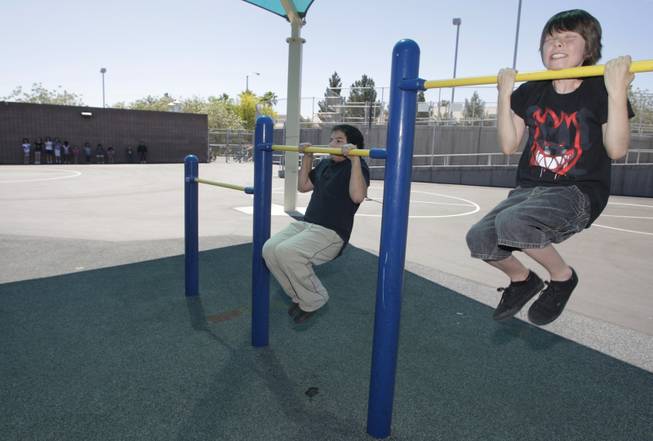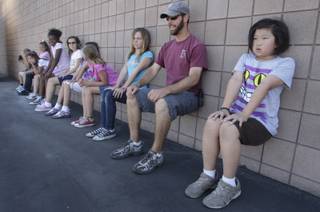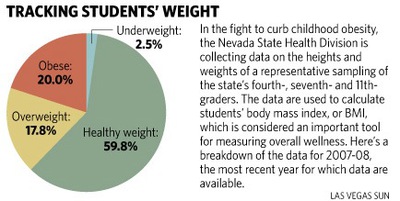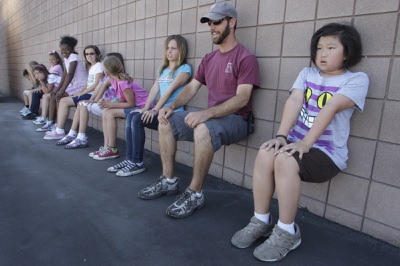
Fourth graders Zachery Padua, left, and Irie Stone do chin-ups during a physical education class at Twitchell Elementary School in Henderson Friday, June 4, 2010.
Monday, June 7, 2010 | 2 a.m.
Sun Archives
- Program for gifted students on hold amid budget crunch (5-18-2010)
- Teachers accept ‘shared sacrifice’ (5-7-2010)
- School District, union reach agreement to save jobs (5-3-2010)
- Recruiting blitz on even as teachers await layoffs (4-27-2010)
- Clark County teachers sweating out the budget crisis (4-22-2010)
- ‘Almost catastrophic’ budget cuts on horizon for Clark County schools (4-22-2010)
- Clark County teachers face peer pressure on furloughs (4-9-2010)
- School Board rejects moving schools to nine-month calendar (3-26-2010)
- Year-round schools could face calendar shift to save money (3-16-2010)
- Teachers resist increasing pressure to accept pay cuts (2-5-2010)
- Budget crunch puts shorter school year, teacher pay cuts on table (2-4-2010)
- Gibbons: School districts should brace for 10 percent cuts (2-2-2010)
- State budget comes up $800 million short (1-22-2010)
- State budget director: Prep for another 10 percent cut (12-15-2009)
Sun Archives
Beyond the Sun
For all the concerns about crowded classrooms, imagine for a moment the effects of crowded gym classes, with physical education teachers trying to manage more than 80 students at a time.
That’s the case at some Clark County schools, and will become increasingly commonplace in August, because of budget cuts.
“Our classroom is the field, and as long as the field can accommodate all the students we’re given, we’ll keep getting more,” complains Hoai-My Winder, who is finishing up the year teaching P.E. at Cadwallader Middle School.
There are no district regulations mandating class sizes for physical education. The National Association for Sport and Physical Education recommends capping elementary P.E. classes at 25, middle school classes at 30 and high school classes at 35, putting them in a range consistent with regular core academic classes. Classes twice that large are not uncommon in Clark County.
The association argues that larger class sizes increase the risk of student injuries and force teachers to spend more time managing student behavior and less time teaching.
Physical education classes help students improve their coordination and motor skills, learn the fundamentals of sports and develop their sense of cooperation and sportsmanship — all of which have been proven to also help them academically, said Joe Migoni, a district elementary P.E. teacher who also is chairman of the professional association’s Southern Nevada chapter.
The actual number of students assigned to a class isn’t the only factor, Migoni said.
With the proper equipment and instructional strategies, “it’s possible to conduct activities where large numbers of students have a high level of involvement,” Migoni said. “The bigger concern is whether those students are going to have the proper level of supervision for that to happen.”
Elementary P.E. teachers are supposed to be assigned an aide when class sizes reach a tipping point (which varies from school to school), but there’s no such support at the middle and high school levels. Migoni noted that he’s been teaching classes of more than 60 students on his own for the past few months, after losing his long-term substitute aide.
Even as P.E. class sizes are increasing, the district is eliminating one of two facilitator positions to coordinate P.E. programs and professional development for more than 350 campuses.
P.E. teachers — also known as specialists — compliment the district for raising physical education’s profile by improving professional development and promoting the program’s importance. For that, they credit Hayden Ross, the facilitator who is being reassigned, a decision they criticize.
The moves are triggered by efforts to balance the district’s budget. The district is increasing class sizes in grades 1-3, which will eliminate the need for 540 teachers. Additionally, the district’s year-round elementary schools are moving to nine-month schedules in August, which will also mean more students on campus at the same time.
And P.E. classes are expected to become bloated.
The changes shouldn’t be viewed as a lessening of the district’s commitment to physical education, said Ray Mathis, executive director of instructional support and student activities. “But we’re talking about less money across the board for all departments. We are doing what we have to do.”
The changes come even as there’s new evidence that physical education is needed more than ever before in local schools, where the incidence of obese children is greater than the national average.
The Nevada State Health Division found that in 2007-08, 20 percent of fourth-, seventh- and 11th-graders qualified as obese, based on their heights and weights. In Clark County, the prevalence of obesity was even higher — 22 percent. Both statewide and locally, another 18 percent of the students qualified as overweight.
Nationally, 17 percent of children and teens qualified as obese in 2006, the most recent year for which data is available from the federal Centers for Disease and Control and Prevention.
The expected changes in the district’s P.E. programs, particularly the loss of one of the facilitator positions, are troubling, said state Sen. Valerie Wiener, D-Las Vegas, who has dedicated much of her legislative career to issues related to children’s health and wellness.
Wiener pointed to a recent report by the Nevada Institute for Children’s Research & Policy at UNLV, which found that in fall 2009, less than half of kindergartners (whose parents took part in a voluntary statewide survey) were a healthy weight. And more than 25 percent were considered obese based on their heights and weights.
“The numbers keep getting worse,” Wiener said. “If we don’t have healthy kids, we can’t have healthy learners.”
In Clark County, elementary students in grades 1-5 typically have P.E. classes twice a week, for 50-minute sessions. In grades 6 and 8, P.E. classes meet every day, and it’s a half-year elective for seventh-graders. High school students must complete physical education credits to graduate.
First lady Michelle Obama visited Red Rock National Conservation Area last week to unveil a new initiative aimed at getting more families active outdoors — part of a wider campaign to end childhood obesity within a generation. During her remarks, Obama noted that the prevalence of childhood obesity has tripled in 30 years. Cuts in education funding haven’t helped, Obama said.
“At a time of a lot of belt-tightening and budget cuts, unfortunately it’s gym class and recess and after-school sports that often are the first things to go,” Obama said.
Star Beltran, a sixth-grader at O’Callaghan Middle School, worries that too many of her peers are on an unhealthy track.
“A lot of children are becoming obese because they don’t eat right or exercise,” said Star, who participated in Obama’s visit to Red Rock along with other students from the “Families in Nature” after-school program at the Winchester Community Center. “Physical education should be every single day for every grade.”
To Twitchell Elementary P.E. teacher Brian Sigler, Clark County’s obesity statistics are troubling — but not surprising. He’s seeing more and more students not only carrying extra pounds, but also struggling to complete basic gym class drills such as pull-ups, jumping rope or running.
Sigler spends a portion of every class on a different type of drill — quizzing students about their major muscle groups, reviewing stretching exercises and talking about healthy habits.
“If they know about their bodies and how they work, they’ll take better care of them,” Sigler said.
But he also knows that 50 minutes twice a week “isn’t very long to cover all that … Schools cannot replace parenting. The best I can do is try and reach the kid, and give them ideas to take home and share. That’s when the real change can happen.”
His average class size is about 60 students, and he teaches one “quad” — four first-grade classes combined, for a total of more than 80 students. Even with top-notch classroom management skills and the help of an aide, it can be a challenge to cover the day’s lesson, Sigler said.
Twitchell Principal Susan Smith said she expects the traveling P.E. teacher to keep the school’s classes from growing when the school year begins in August. She added that she considers Sigler “to be just as important as any other teacher” to the school’s overall mission.
P.E. teachers have long struggled for respect, said Shenoa Davis, who is in her 11th year with the district. Until physical education is somehow tied to the state and federal performance benchmarks used to measure school achievement, “we’re going to take the back seat,” said Davis, who teaches at Chaparral High School.
Davis suggests the district increase its graduation requirement for physical education. Currently students must take two years of P.E., although participating in a sport can satisfy one year. Many students complete those requirements in their freshman year and then do not take part in any regular physical activity.
“That means I have one year to tell them that heart disease is the No. 1 killer of Americans, and exercise can prevent that,” Davis said. “If every student were required to take physical education, we might have a better shot at getting more kids into healthy habits.”
Winder — who is moving on from Cadwallader to the Northwest Career and Technical Academy in August — has a master’s degree in math but chooses to teach physical education because she believes in its value.
“A generation of unfit children becoming unfit adults will be a drain on society,” Winder said. “It doesn’t matter how well you read or how well you write if you’re not physically fit enough to do the job.”




Join the Discussion:
Check this out for a full explanation of our conversion to the LiveFyre commenting system and instructions on how to sign up for an account.
Full comments policy